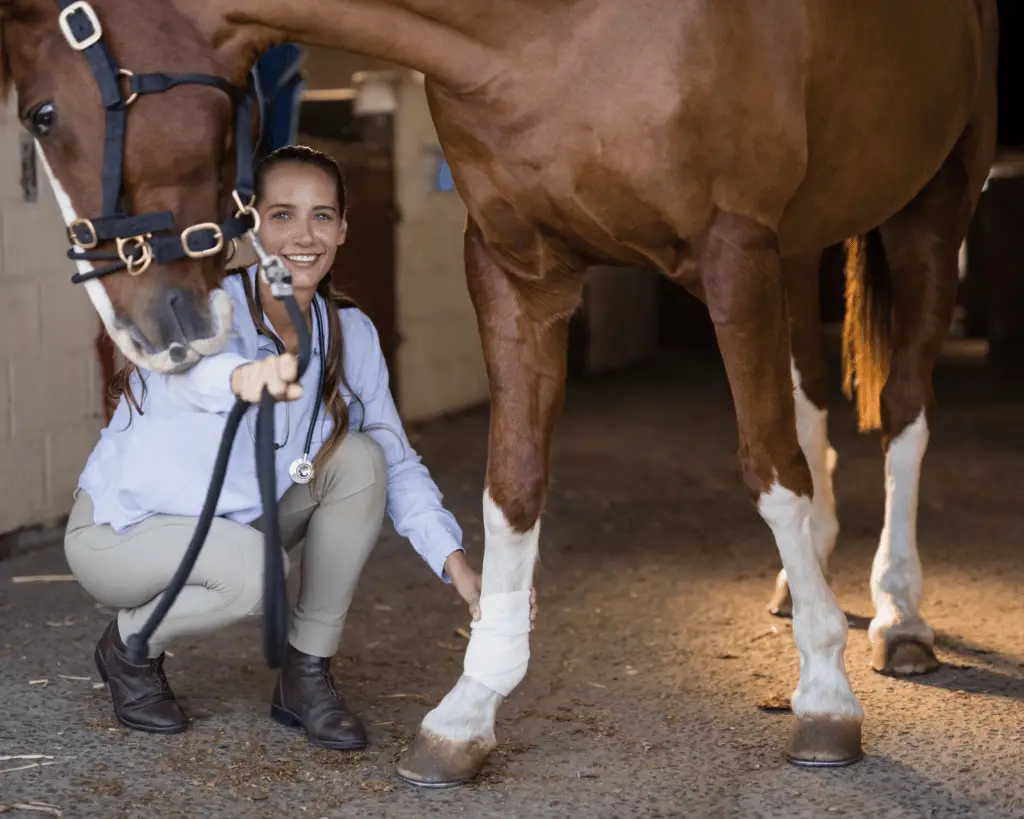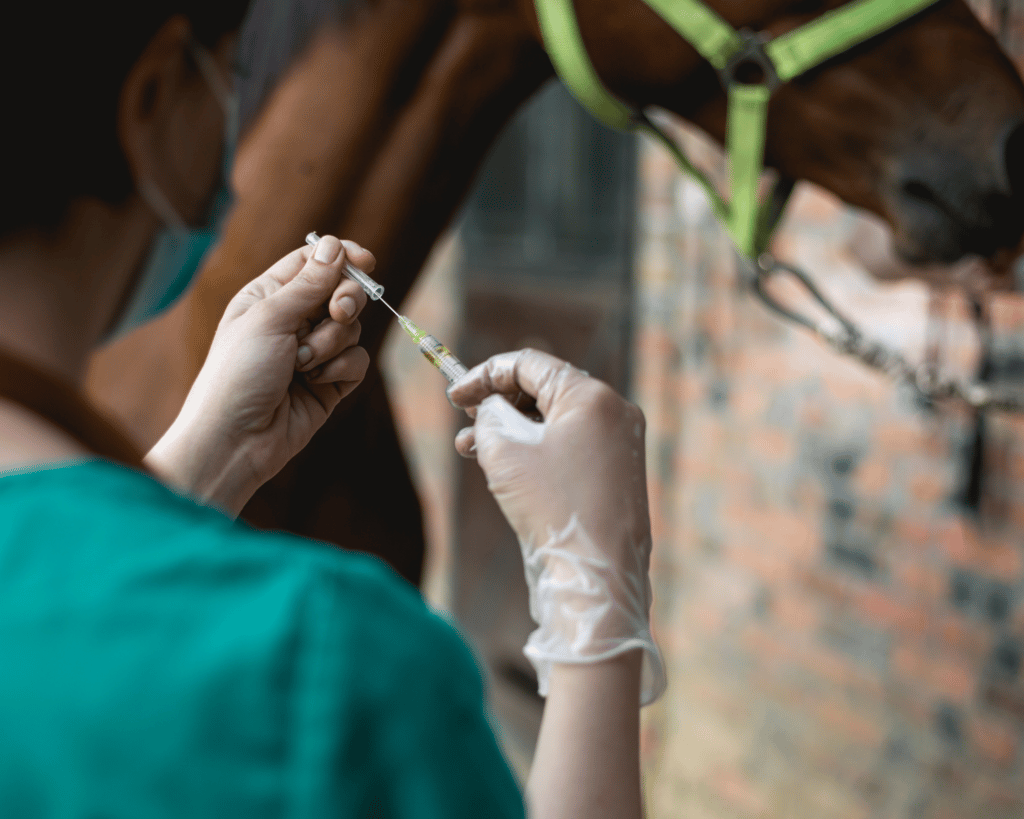Degenerative suspensory ligament disease/desmitis, or DSLD, is a condition that affects the suspensory ligament in the lower leg of the horse. All four legs can be affected, and the cause of the condition is unknown. Certain breeds are more likely to develop the condition, but it can happen in all breeds, ages, sizes, and sexes of horses.
DSLD is a chronic issue that can be treated and allow a horse to be reasonably functional. Its visual appearance is unsightly and looks uncomfortable, with horses typically displaying signs of discomfort as the condition progresses. Because it’s a chronic condition with no cure, there will come a time when the decision of when to euthanize a horse with DSLD needs to be made. The following is a look at DSLD and how it impacts a horse’s quality of life.
What is DSLD?
Degenerative suspensory ligament disease (DSLD) affects the major suspensory ligament (SL) that runs from the horse’s knee in the front legs and hocks in the rear to the fetlock, and splits into two around the sesamoid bones. A horse can have DSLD in one or all limbs, but its presentation is typically in both front and/or hind legs. The condition causes the SL to break down over time and causes the angles of a horse’s legs to change. As the SL breaks down, so do other structures in the legs with the formation of osteoarthritis in nearby joints.
One factor that can affect DSLD involves proteoglycans. These are proteins that help support the cells that comprise tendons, ligaments, and joints. An overabundance of proteoglycans in a section of connective tissue causes it to break down.
Injury to the SL is common in sport horses as they take a lot of strain on their front legs while they perform. DSLD, on the other hand, begins on its own with no help from a prior injury. It’s slow to develop and is usually preceded by vague pain in the afflicted legs.
The condition affects more than the SL, however, and the presence of DSLD has been found in the cardiovascular system, sclera of the eye, patellar ligament, deep digital flexor tendon, and nuchal ligaments. What this means is that a horse who presents with DSLD in the lower legs may also be affected elsewhere in its body.
DSLD reduces the ability of the SL to return to its original tensile condition. Instead, it allows it to stretch out permanently and allow the lower joints to stay in a permanently sunk state. That is, the fetlock joint develops an extreme angle that’s almost parallel to the ground and causes the hoof to develop a low angle and a bull-nose appearance. Sometimes the fetlock touches the ground because there’s no elasticity in the SL to hold it upright.
Catching the signs of DSLD early can help slow down the progression of the disease, but there is no halting or reversing the condition. Let’s talk about what to look for in your horse…
Signs and Symptoms of DSLD
The onset of DSLD is often subtle and mimics the appearance of an injury, but only in the fetlock joint. There typically is no involvement of the higher joints during the early stage of DSLD. You’ll notice that the swelling and heat won’t resolve with treatment and support. Over time, the fetlocks start to droop and lose their angle, becoming more and more parallel with the ground. The fetlock joint enlarges with fluid and tends to stay in that state.
Signs of lameness become more apparent and won’t resolve through treatment. You may also notice that the SL feels thicker and harder than it should, and the area feels hot and swollen. The horse’s gait may become unstable and appear as if it has a neurological condition due to the weakened nature of its SL. You may notice the horse shifts frequently, leans against nearby walls or objects, is prone to tripping or stumbles, and is generally irritable.
A veterinary call is required to rule out or confirm a diagnosis of DSLD. The vet performs an ultrasound image of the fetlock joint and looks for irregularities in the fiber of the tendon along with other signs including calcification of the ligaments and tears. If any of these signs are present, the vet will confirm a diagnosis of DSLD and prescribe appropriate treatment.

Treating a Horse with DSLD
Treatment for DSLD is varied and consists of finding a combination of medications and supplements that are effective. All treatments only address the condition, as there is no cure for DSLD. However, in order to keep a horse comfortable and usable, treatment is highly recommended along, with proper maintenance.
Glucosamine
Ligaments are made up of connective tissue, and glucosamine is a key building block in connective tissue. Oral supplements work, but they have to be processed through the liver prior to transportation through the bloodstream. Acetyl-D-glucosamine in IM form is more effective as the injection bypasses the liver. The end result is that a larger amount of glucosamine reaches the SL.
Shoeing
Shoeing a horse with DSLD tends to be a bit controversial, with some experts finding it doesn’t alleviate the issue, while others find it effective in giving a horse pain relief. The most common method of shoeing is to use an egg bar shoe with a wedge in front and a patten shoe in the rear. The egg bar transfers the loading of the heel from an advanced angle to one that’s closer to the original angle. The addition of the wedge lifts the heel and takes stress off the SL.
Pain relief
Phenylbutazone and Banamine help reduce swelling and minimize pain signals. Analgesics can’t cure, but they can keep a horse comfortable. MSM is another option for pain relief and has fewer long-term side effects than Banamine. However, always consult with your veterinarian about the type of pain relief you should provide your horse for comfort.
Leg Wraps or Boots
Fleece wraps/bandages or boots that are designed to sling underneath the fetlock joint help support the SL and take off the pressure on ligaments and tendons. Wrapping the leg in a fashion that goes underneath the fetlock helps to “pick up the slack ” out of the SL and reduces strain. The same goes for brushing boots and ones designed for tendon support.
Stem cell injections
Stem cell therapy is a relatively new therapy for treating DSLD and shows promise in providing pain relief along with restoring a horse with DSLD back to light riding. However, the procedure is considered novel for DSLD in that the long-term prognosis is positive, but still uncertain. Stem cell therapy may be worth trying as it has the potential to reduce the amount of maintenance a horse with DSLD requires.

Does DSLD Cause Pain in Horses?
As a general rule, DSLD does cause discomfort and pain in horses. However, because it’s a chronic condition, a horse may not exhibit signs of pain as they get used to living with the issue. Their gait adapts to the lack of resistance in the SL and they sometimes move as if there’s nothing wrong with their legs. However, every horse is different in terms of presentation and you should respond accordingly in terms of treatment and letting them rest.
Horses are stoic and tend not to show signs of pain unless they’re hurting to a point where movement is difficult. You can check for pain levels by palpating the afflicted legs with your fingers. A horse in pain will react by flinching or pulling away from the pressure. Their reaction informs you about how they’re feeling and what actions you need to take to provide them with pain relief and comfort.
Can You Ride a Horse With DSLD?
It’s not generally advised to ride a horse with DSLD. A rider adds more weight to the horse and puts more strain on the ligaments. However, a horse with DSLD needs to move in order to keep its ligaments in good shape and maintain its strength. Retraining the horse to drive is sometimes recommended due to the fact that the tendons and ligaments get used under a light load without the added weight of a rider. The action of drawing a light cart forward is more beneficial to stretching and strengthening ligaments than carrying a rider.
How Long can a Horse Live With DSLD?
A horse with DSLD can live a long time with proper care, treatment, and shoeing. An owner of an afflicted horse needs to stay on top of the needs of their horse and take note of changes in condition. Working closely with a veterinarian is also advisable as the vet stays on top of the latest treatments for chronic diseases and can readily suggest trying something new. Alternatively, if the current treatment is working just fine, the vet can help with maintenance and alter medications as needed.
Most cases of DSLD follow the path of slow decline, especially when palliative measures are being taken. A horse can go a long time before having an episode where the SL breaks down further and causes the lower joints to slump even further. Even then, treatment can help with pain relief and can support the SL for some time to come.
Unfortunately, DSLD is a chronic condition with no cure, even though a horse can live out its years with relative ease and comfort. However, knowing when to euthanize a horse with DSLD can be tricky as a horse can put up with a lot of pain and seem normal. There may also come a point where the horse is unable to rise from a lying position and requires the mercy of euthanasia. Always consult with your vet about your horse’s quality of life and let them guide you with their experience with euthanizing a horse with DSLD.

